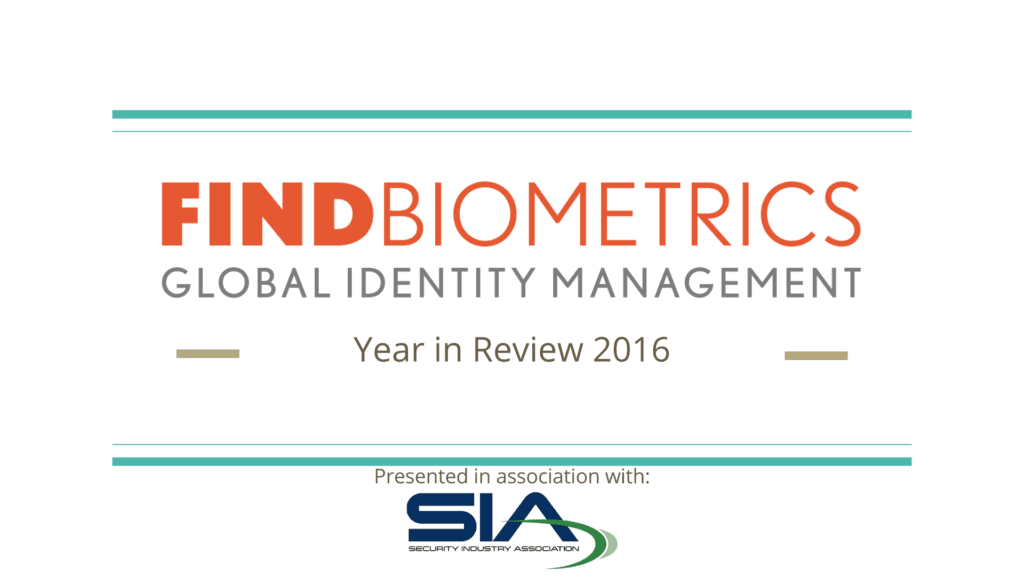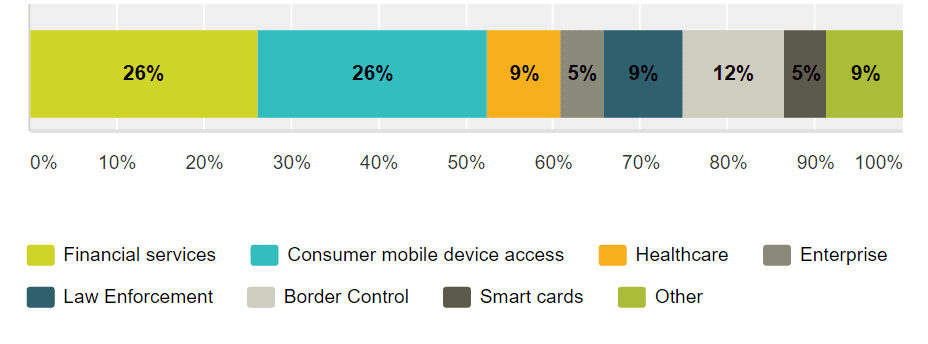In December we polled 165 professionals in biometrics and identity related industries about various topics from the past year. It was part of the FindBiometrics Year in Review, the longest-running and best regarded industry retrospective of its kind. Now in its 14th consecutive year, the FindBiometrics Year in Review is your resource to start 2017 off with your fingers on the pulse of biometrics and global identity management.

In our first post of Year in Review analysis we found that the majority of our survey respondents agreed 2016 was the first year biometrics truly felt like mainstream technology. Thinking back on the last 12 months it’s easy to see why: biometrics were being deployed constantly across a wide range of consumer-facing and vertical markets, bringing strong ‘who-we-are’ authentication into the real world where it can be used. But, while it’s clear that biometrics are popular in the big picture, it’s important to take a look at where biometrics raised the most eyebrows in 2016.
We asked our survey respondents to tell us which areas of application for biometrics they found the most interesting in 2016.
Here’s what they said:

The results here are fascinating, if a bit predictable. In the first place we see a tie between financial services and consumer biometrics, distantly followed by border control applications in second place, and then law enforcement and healthcare tied for third place with the miscellaneous ‘other’ applications. During our Year in Review analysis over the next few days, we will be deconstructing these results, looking at what made these spaces so interesting in the world of biometrics. To start things off we’ll be looking at our two first place votes.
Consumer Applications
 Consumer biometrics saw a period of re-invigoration in terms of exciting launches and deployments in 2016. While smartphone-mounted fingerprint sensors have been consistently gaining in popularity and ubiquity since the launch of Apple’s Touch ID on the iPhone in 2013, and biometric features themselves were thusly becoming normalized in the eyes of consumers, last year was exceptional in greatly broadening the conversation around consumer biometrics. Fingerprint sensors made their way under the glass of smartphones in 2016, numerous products supporting the Windows Hello biometric security platform were available for purchase, and the launch of an iris-scanning flagship device from Samsung really got the conversation moving to multimodality like never before.
Consumer biometrics saw a period of re-invigoration in terms of exciting launches and deployments in 2016. While smartphone-mounted fingerprint sensors have been consistently gaining in popularity and ubiquity since the launch of Apple’s Touch ID on the iPhone in 2013, and biometric features themselves were thusly becoming normalized in the eyes of consumers, last year was exceptional in greatly broadening the conversation around consumer biometrics. Fingerprint sensors made their way under the glass of smartphones in 2016, numerous products supporting the Windows Hello biometric security platform were available for purchase, and the launch of an iris-scanning flagship device from Samsung really got the conversation moving to multimodality like never before.
In terms of numbers, Acuity Market Intelligence’s latest report helps illustrate just how much activity is happening in the consumer biometrics market. According to Acuity, there are currently 500 biometric smartphone models on the market from 87 different vendors, and of those models 120 of them are available for under $150. The takeaway: consumer biometrics are not only more accessible, they’re on track to becoming nigh unavoidable.
Furthermore, 2016 laid the groundwork for an exciting 2017 in biometrics. With smart home technology and artificial intelligence gaining momentum, we are seeing an increased interest in consumer-facing voice and speech recognition—one of the hot topics at this month’s CES. Last year we also saw Touch ID integrated with that Macbook Pro, as well as other high profile PC sensor integrations, which may indicate that biometrics are going to further take on personal authentication needs. Finally, rumors currently circulating surrounding the next iPhone and Samsung Galaxy handsets are painting an exciting year ahead of us when it comes to how consumers will be given a choice to authenticate.
Financial Services
![]() There is some overlap between financial services and consumer applications. For a very long time the use-case for consumer biometrics has been mobile payments, with mobile wallets like Samsung Pay requiring a fingerprint or iris scan for transaction authentication. In 2016 that didn’t change—with biometric authentication becoming such an integral part of the mPayments equation it often went without mention in news about mobile commerce. When it comes to mobile payments, biometrics are simply expected.
There is some overlap between financial services and consumer applications. For a very long time the use-case for consumer biometrics has been mobile payments, with mobile wallets like Samsung Pay requiring a fingerprint or iris scan for transaction authentication. In 2016 that didn’t change—with biometric authentication becoming such an integral part of the mPayments equation it often went without mention in news about mobile commerce. When it comes to mobile payments, biometrics are simply expected.
That having been said, there was a lot of very exciting news in the consumer-facing financial services biometrics space in 2016. Mastercard’s Identity Check Mobile (aka Selfie Pay, which is powered by Daon’s biometric technology) was launched, and Alipay operator Ant Financial acquired eye-vein biometrics company EyeVerify. The consumer was a big part of the conversation at Mobile World Congress events and also Money20/20 events, particularly when FinServe powerhouses like Visa were talking about new biometric initiatives.
— Check out our our Financial Biometrics Month coverage to read more on this topic —
In 2016 the idea of ‘naked payments’—solutions that allow users to pay with nothing other than their biometrics—entered the conversation in very tangible ways. Some of the more exciting instances of this were the Scan&Pay concept demonstrated by Safran Identity & Security, which allows users to transact via MorphoWave contactless biometrics, and also the project currently underway in Japan that aims to allow tourists attending the upcoming Tokyo Olympics pay for goods and services using only their fingers. Look out for more naked payments in the coming months, as we have already seen news on this topic in 2017.
Like in the consumer space, voice biometrics technology was also a fixture of the financial services news last year. The vocal modality continued to see deployment in phone banking call centers around the world, allowing banks to verify caller identities without resorting to cumbersome security questions. Moving further behind the scenes, behavioral biometrics saw a rising interest in anti-fraud applications for online financial transactions such as online banking.
Indeed, financial and consumer biometrics were not only extremely interesting in 2016, they were incredibly visible. But of course, as our results show, they weren’t the only applications in town either. Stay tuned this week as we look at more of 2016’s most interesting areas of application for biometrics.
*
Stay posted to FindBiometrics throughout January as we continue to breakdown our Year in Review 2016 results.
The FindBiometrics Year in Review is presented in association with SIA and made possible by our sponsor: Tascent


Follow Us